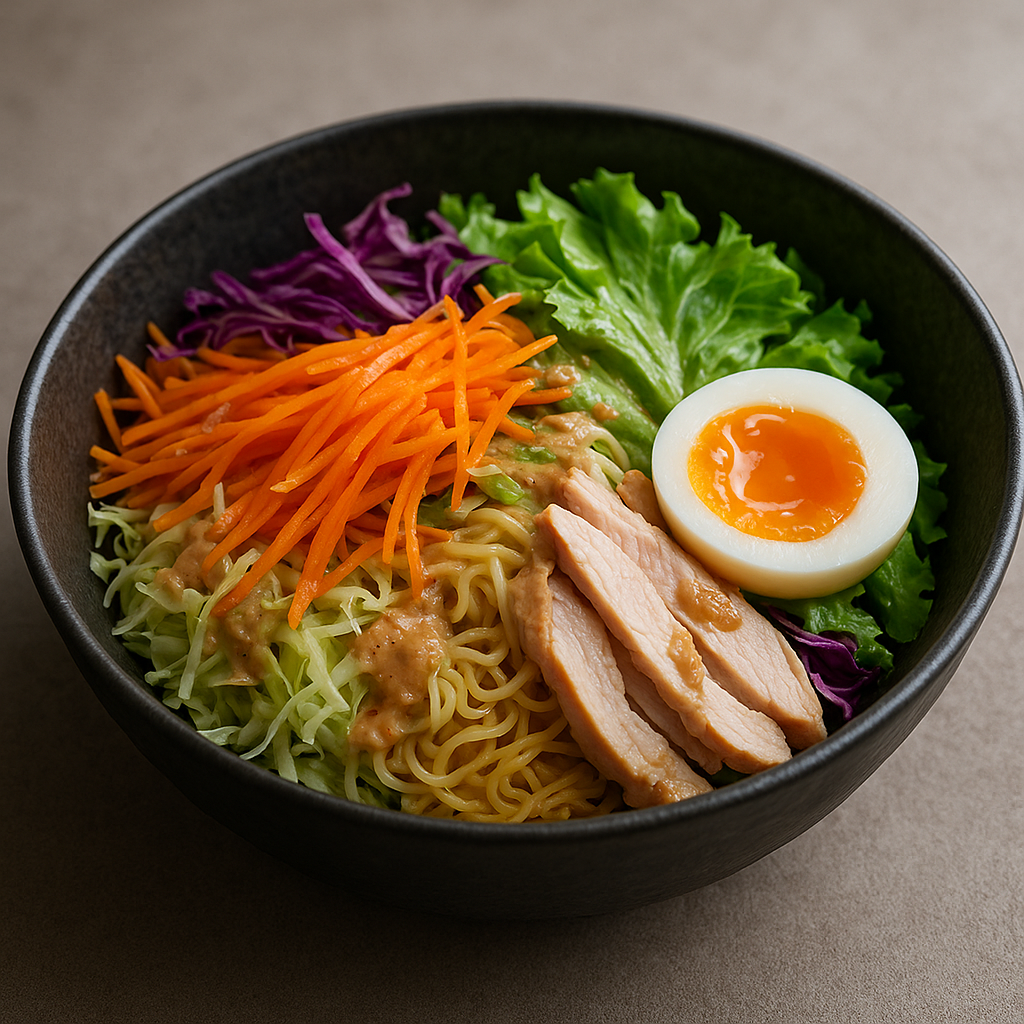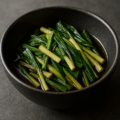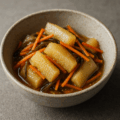ラーメンサラダの特徴
冷やし麺とサラダの融合
ラーメンサラダは、茹でて冷やした中華麺にたっぷりの生野菜とタンパク質を合わせ、ドレッシングで仕上げる北海道発のご当地メニューです。さっぱりしつつ食べ応えがあります。
ドレッシングで広がるバリエーション
ごまドレッシングや和風しょうゆ、シーザー風、ピリ辛系など、店や家庭ごとに味が異なります。具材の自由度が高く、四季に合わせてアレンジできます。
居酒屋・ホテルから家庭へ定着
夏場の定番メニューとして飲食店で人気を集め、現在は家庭料理やコンビニ商品としても広く親しまれています。
ラーメンサラダのレシピ
材料(2人分)
- 中華麺(生または蒸し) … 2玉
- レタス … 100g
- 人参…1/2
- きゅうり … 1/2本(細切り)
- トマト … 1個(くし形)
- 蒸し鶏(むね)… 120g(細切り)
- ゆで卵 … 1個
- キャベツ…3枚
- 紫キャベツ…1枚
- 白ごま … 適量(仕上げ用)
ごまドレッシング(自家製・目安)
- すりごま … 大さじ2
- 醤油 … 大さじ2
- 酢 … 大さじ2
- 砂糖 … 大さじ1
- ごま油 … 大さじ1
- マヨネーズ … 大さじ1(好みで)
- 水 または だし … 大さじ1〜2(濃度調整)
作り方
- 麺を表示時間どおりに茹で、冷水→氷水でしっかり締める。水気をよく切り、くっつき防止にごま油(分量外)を少量絡める。
- 野菜とタンパク質(ハムまたは蒸し鶏、ゆで卵)を食べやすく切る。
- ドレッシング材料を混ぜ、味をととのえる。
- 器に麺→野菜→タンパク質の順に盛り、ドレッシングをかける。刻み海苔や白ごまを散らして完成。
シェフのワンポイントアドバイス
麺は「やや硬め」に茹でて氷水でキュッと締めると、食感と絡みが良くなります。
野菜は水気をしっかり切ると味がぼけません。
タンパク質は蒸し鶏・ツナ・豆腐などでアレンジ可。
カロリーを抑えたい場合は麺を少なめにして葉物を増やすとバランスが取れます。
ラーメンサラダの栄養価(1人分の目安)
- エネルギー:約500〜650 kcal(具材とドレッシング量で変動)
- たんぱく質:20〜30 g(蒸し鶏・卵の有無で変動)
- 脂質:15〜25 g(主にドレッシング由来)
- 炭水化物:60〜75 g(主に麺由来)
- 食物繊維:4〜6 g(野菜由来)
- ビタミンC・カリウム(野菜由来)
主食・主菜・副菜を一皿で摂れるバランスの良いメニューです。塩分はドレッシング量で調整しましょう。
ラーメンサラダの歴史
飲食店メニューとしての誕生
冷製の中華麺をサラダ仕立てにした発想は、北海道(特に札幌)の居酒屋やホテルのメニューから広がったといわれます。
夏の定番として普及
さっぱりしながら満足感があることから、夏場の人気メニューとして外食・家庭の双方で定着しました。
多様化と全国展開
ごま・和風・シーザーなど多様なドレッシング、海鮮・蒸し鶏・豆腐など具材の自由度が高く、コンビニやチェーン店でも見られる身近な一品となりました。
English Version
Features of Ramen Salad
A Fusion of Cold Noodles and Salad
Ramen Salad is a local dish from Hokkaido, made by combining chilled Chinese noodles with plenty of fresh vegetables and protein, then finished with dressing. It is refreshing yet filling.
Variety Through Dressings
From sesame dressing and soy-based styles to Caesar and spicy versions, the flavor varies by restaurant or household. With high flexibility in ingredients, it can be adapted for any season.
From Izakaya and Hotels to Homes
First popular in restaurants during summer, Ramen Salad has since spread to households and even convenience stores as a widely loved dish.
Recipe
Ingredients (for 2 servings)
- Chinese noodles (fresh or steamed) … 2 portions
- Lettuce … 100 g
- Carrot … 1/2
- Cucumber … 1/2 (julienned)
- Tomato … 1 (wedges)
- Steamed chicken breast … 120 g (sliced)
- Boiled egg … 1
- Cabbage … 3 leaves
- Purple cabbage … 1 leaf
- White sesame seeds … to taste (for garnish)
Sesame Dressing (homemade, approximate)
- Ground sesame … 2 tbsp
- Soy sauce … 2 tbsp
- Vinegar … 2 tbsp
- Sugar … 1 tbsp
- Sesame oil … 1 tbsp
- Mayonnaise … 1 tbsp (optional)
- Water or dashi … 1–2 tbsp (to adjust thickness)
Instructions
- Cook the noodles according to package instructions, then chill in cold water and ice water. Drain thoroughly and coat lightly with sesame oil (extra) to prevent sticking.
- Prepare the vegetables and proteins (steamed chicken, ham, or boiled egg) into bite-sized pieces.
- Mix the dressing ingredients and adjust the taste.
- Plate the noodles first, then add vegetables, followed by protein. Pour the dressing on top and garnish with seaweed or sesame seeds.
Chef’s Tip
Cook the noodles slightly firm and chill well in ice water for the best texture and flavor. Drain vegetables thoroughly to avoid diluting the taste. Protein can be varied with steamed chicken, tuna, or tofu. To reduce calories, use fewer noodles and more leafy vegetables for better balance.
Nutritional Value (per serving, approx.)
- Calories: 500–650 kcal (depending on toppings and dressing)
- Protein: 20–30 g (varies with chicken and egg)
- Fat: 15–25 g (mainly from dressing)
- Carbohydrates: 60–75 g (mainly from noodles)
- Dietary fiber: 4–6 g (from vegetables)
- Vitamin C and potassium (from vegetables)
A well-balanced dish that combines staple, protein, and vegetables in one bowl. Adjust sodium intake by controlling the dressing amount.
Historical Background
Origin as a Restaurant Menu
The idea of serving chilled Chinese noodles in a salad style is believed to have originated in Hokkaido, especially in izakaya and hotels in Sapporo.
Spread as a Summer Staple
Its refreshing yet satisfying taste made it a popular summer menu item in both restaurants and households.
Diversification and National Expansion
With dressings ranging from sesame to soy and Caesar, and ingredients such as seafood, chicken, or tofu, the dish became versatile. Today, it is commonly found in convenience stores and chain restaurants nationwide.



何でも質問してください!